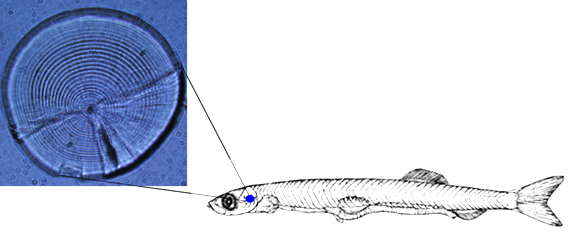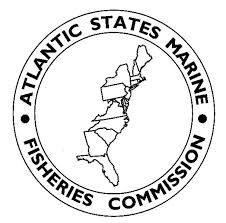Ingress of Atlantic menhaden larvae into Chesapeake Bay
The Atlantic menhaden is a key forage species, serving as food for fish and bird predators. Additionally, it supports the biggest fishery in Chesapeake Bay. Reproductive success, measured as abundance of juveniles, has been low for nearly 25 years, following a period of high abundance in the 1970-1980s. We hypothesized that a decline in the offshore supply of menhaden larvae to Chesapeake Bay was a probable contributor to low juvenile abundance. Atlantic menhaden spawns in the ocean and its eggs and larvae depend on hydrodynamic transport for delivery to estuarine nursery grounds.
Menhaden larvae were sampled at the mouth of Chesapeake Bay from 2005 through 2008 (Fig 1 a, b) to estimate abundance at ingress and to document age and growth, hatch dates and their inter-annual variability. Another goal was to relate larval ingress to subsequent levels of juvenile abundance.

Fig 1. Collecting Atlantic menhaden larvae at the mouth of Chesapeake Bay: a) deploying a “Tucker Trawl” from a research vessel to sample larvae and zooplankton; b) a collection of menhaden larvae from the Bay mouth in December 2007.
Ingress varied 9-fold in the three years of this study and was highest in 2007-08 (Table 1). The abundances of larvae at ingress were not concordant with subsequent abundances of juveniles (Table 1), indicating that processes operating on juveniles after larval ingress are important in controlling juvenile abundance.
The earbones (otoliths) of larval menhaden, which lay down daily rings, were analyzed to determine ages, hatch dates and growth rates (Fig 2). At ingress, larvae averaged 47-days old in the three years. Peak hatch dates differed inter-annually. Growth rates differed modestly among years but were significantly faster in 2007-08 (Fig 3; Table 1).

Fig 2. Saggital otolith from a larval Atlantic menhaden collected at the mouth of Chesapeake Bay. This individual was estimated to be 41-days old and was 19-mm long at capture.
In 2010-2011, we also have examined “transition-stage” Atlantic menhaden, the stage just before larvae transform to juveniles. Transition-stage menhaden were only a few days older than ingressing larvae (Table 1). Mean ages of transition-stage menhaden increased up-Bay, indicating up-Bay movement of larvae after ingress.
It has been a challenge to relate the larval supply of menhaden to abundances of transition-stage larvae and juveniles. During our study juvenile abundances were consistently low and quite stable. Monitoring larval ingress, and transition-stage and juvenile menhaden in the Chesapeake Bay and coast-wide is important to understand processes that control abundance.
Table 1. Atlantic menhaden, 2005 to 2011: concentration (number per 100 m3) of larvae at the Chesapeake Bay mouth, age at larval ingress (days), age of transition-stage larvae, length at larval ingress (mm), larval growth rates (mm∙d-1), transition-stage growth rates, and subsequent summer juvenile abundance (number per m2) in Chesapeake Bay. Juveniles are from seine surveys conducted by Maryland Department of Natural Resources in the Maryland portion of the Chesapeake Bay.

Recent Publications
- Lozano, C., E. D. Houde, R. L. Wingate and D. H. Secor. 2012. Age, growth and hatch dates of ingressing larvae and surviving juveniles of Atlantic menhaden Brevoortia tyrannus. Journal of Fish Biology 81, 1665-1685.
- Lozano, C. and E. D. Houde. 2013. Factors contributing to variability in larval ingress of Atlantic menhaden, Brevoortia tyrannus. Estuarine, Coastal and Shelf Science 118, 1-10.





